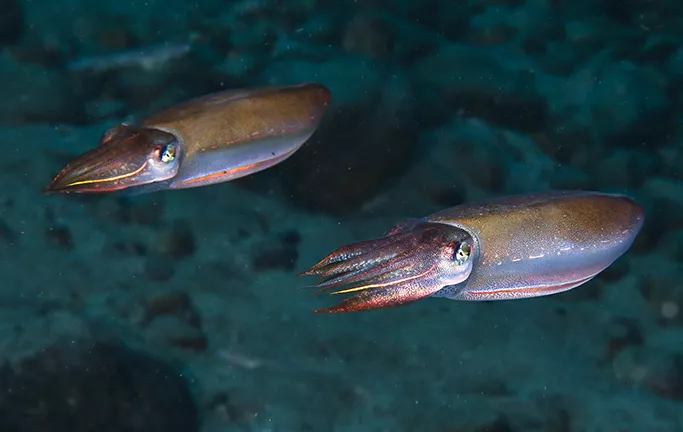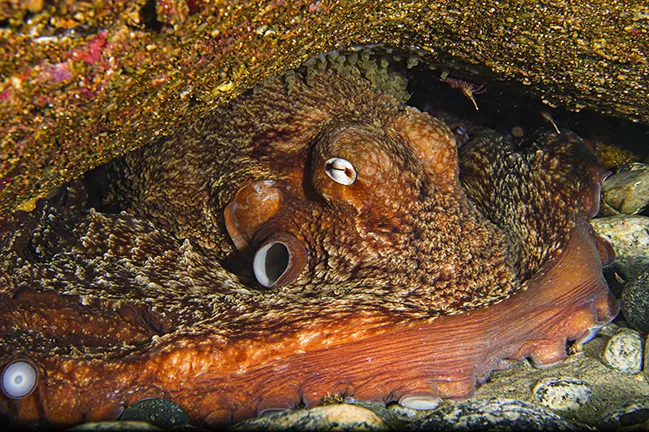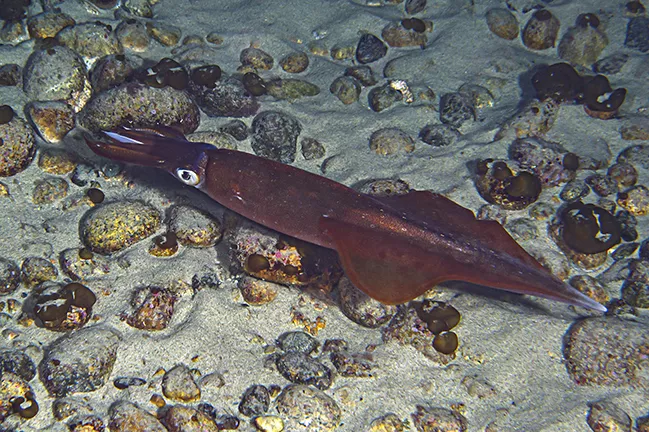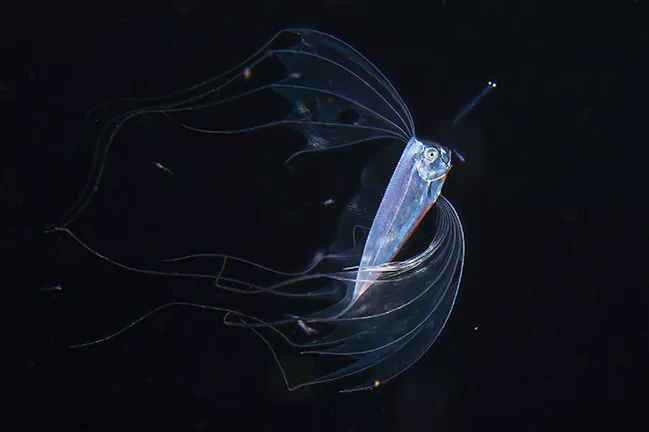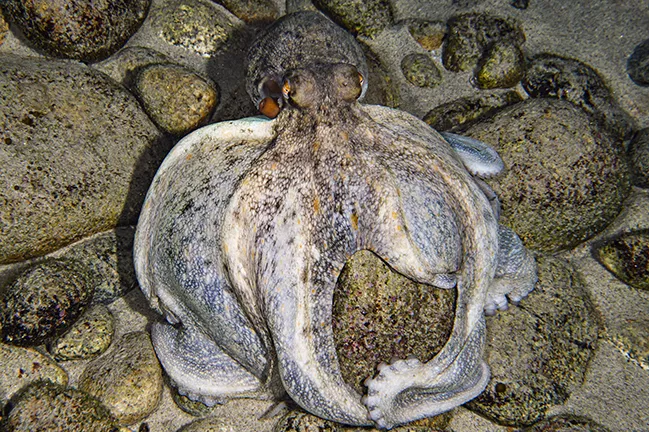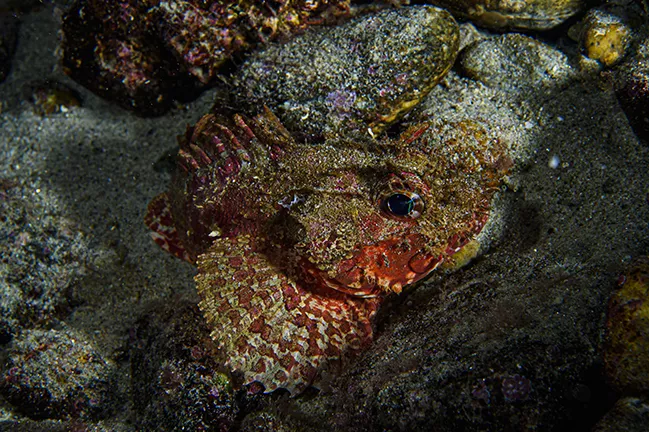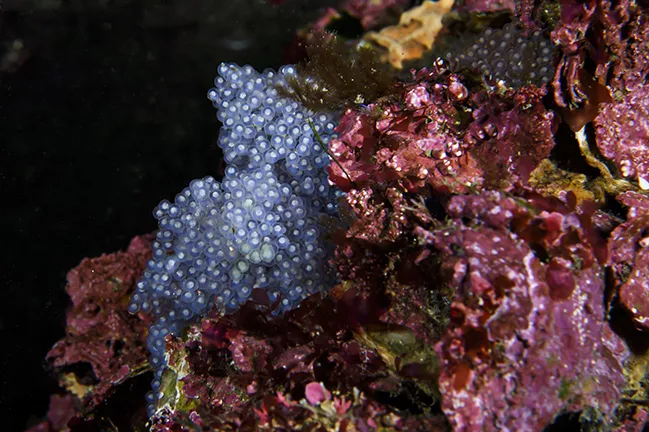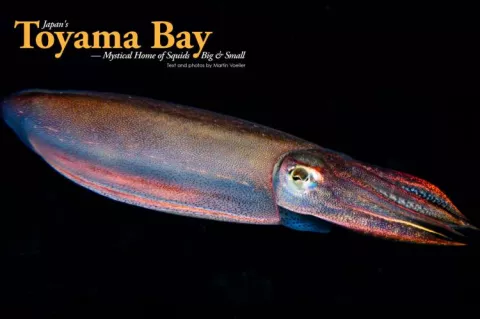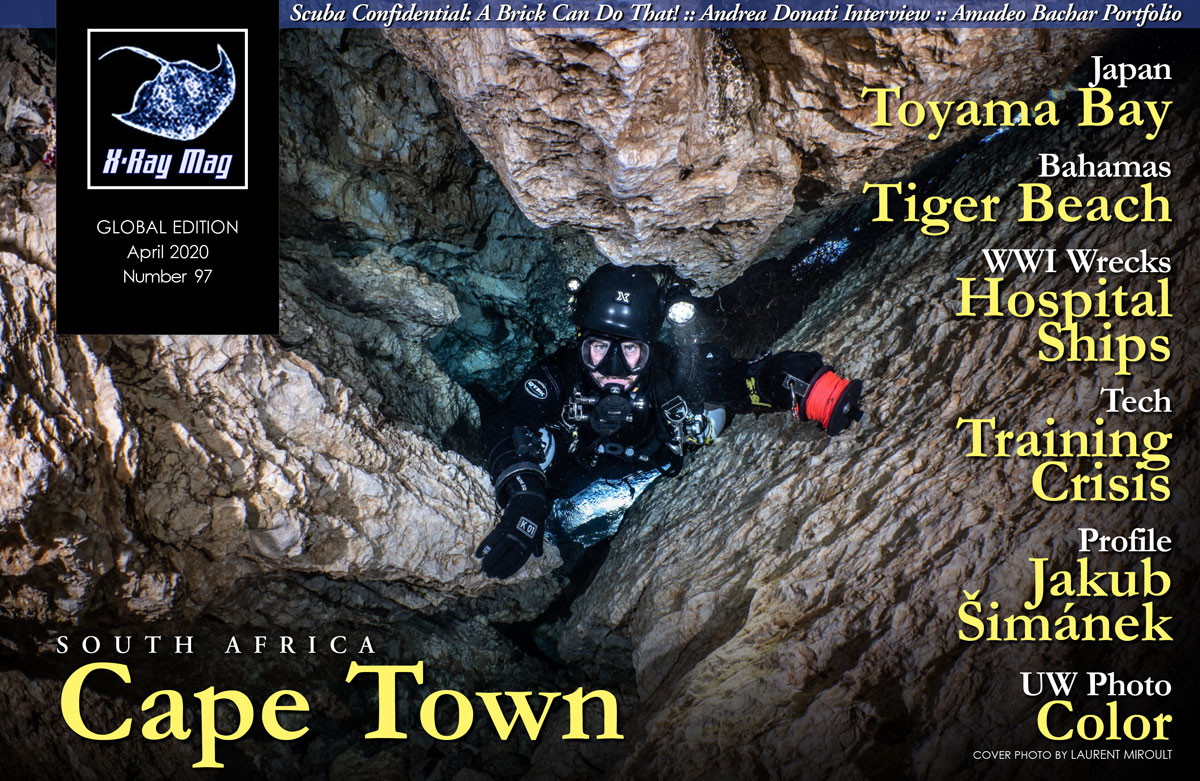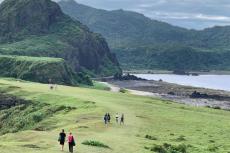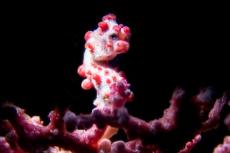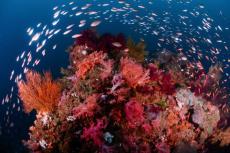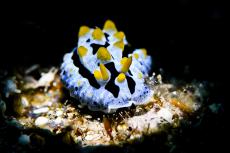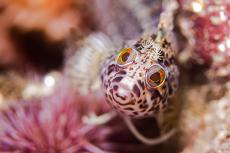Many people outside Japan have probably never heard of Toyama or even know where it is exactly, but the ocean enthusiasts who have heard of it probably associate Toyama with squids, both big and small. The video of a 10-meter-long giant squid filmed in Toyama Bay by the owner of Diving Shop Kaiyu during Christmas 2015 went viral globally—such sightings are rare, but these squids pop up on an average of once a year in the bay.
Contributed by
Factfile
Japan National Tourism Organization (JNTO) has launched a site called “Dive in Japan” to welcome divers from all over the world. You can choose from a menu of over 170 dive locations in Japan.
For further information about diving in Japan via JNTO, please visit: japan.travel/diving/en/.
Martin Voeller is an avid diver and underwater photographer based in Tokyo, Japan. Diving since 2011, he is a certified NAUI Divemaster and serves as a dive guide in the Kanto area. Having dived from the southernmost tip of Japan (Okinawa) to the northern tip (Hokkaido) and much more in between, he enjoys the variety of diving that Japan offers, ranging from tropical to cold water.
He continues to explore Japan’s diverse undersea formations and topography, and his mission is to share this with the rest of the world.
See more of his underwater images at: poseidonphotos.com.
During early spring of each year, the firefly squids ascend to the surface and put on a transcendental show of their own—their luminous organs glow bright blue as they spawn and are agitated by waves on the ocean surface near the shoreline. This results in the shorelines being blanketed in blue jewels at night, a scene that attracts many people each year for this special, mystical encounter.
Squids are not the only attraction of Toyama, however. The ocean here is unique in its own right, and although I secretly wished for an encounter with a giant squid like in Jules Verne’s Twenty Thousand Leagues Under the Sea, I reached out to Mr. Akinobu Kimura of Diving Shop Kaiyu to guide and show me what this mystical ocean offers.
Juxtaposing a natural fish tank with the Japanese Alps
Toyama Bay is located in the center of the Sea of Japan and is affected by the Tsushima Current. Whereas the Kuroshio Current brings up warm water filled with tropical fish and exotic sea creatures to Izu Peninisula from the Pacific Ocean (see my previous article in issue #95 on diving in Izu), the Tsushima Current is the northeastward-flowing branch of the Kuroshio along the western coast of Japan, which reaches down to 300m from the sea surface.
This current affects the bay typically during the warm summer months, where the sea temperatures can go up to 30°C (86°F). Sea life which prefers warmer waters thrive in this zone, but during the winter months when this current is absent, the sea temperatures near the surface can dip down to 8°C (46°F). That is a whopping 22 degrees difference between the two opposite seasons.
One distinct marine feature of Toyama Bay is its steep terrain. Toyama Bay is 1,200m deep, and this depth can be observed just a short distance away from the coast—because of the steep slope to the ocean floor, the bay quickly becomes very deep. The upwelling currents from the sea floor bring exotic, cold-dwelling, deep-sea creatures from the bay’s dark depths, and because this is so near the coast, it is not uncommon for divers to encounter such marine life.
And due to this close proximity from the port, the bay is like a fish tank for the local fishermen. Some species, like broad velvet shrimp and firefly squid, can only be caught here, and they are local delicacies. Also popular from the bay as seafood are the red snow crabs and yellowtail fish.
Opposite the bay lies mountainous terrain, which is part of the Japanese Alps, and the mountain ranges covered in snow on a clear, winter day will take your breath away. Snow, which falls on these 3,000m high mountains, eventually melts and becomes part of the seven rivers that pour into Toyama Bay. Freshwater pouring into ocean water creates water of different salinities.
As a result, the visibility can become blurry near the surface. Yet, this fast-flowing and nutrient-rich mixture is the reason why the bay has such a fertile marine environment. Out of the 800 species found in the Sea of Japan, 500 can be found in Toyama Bay—the biodiversity is exceptional and unique here.
Breeding and brooding grounds
Because of the lower salinity on this side of the ocean, corals—both hard and soft—do not thrive in Toyama Bay, unlike in Izu’s Pacific Ocean. As soon as you enter the water, the terrain is bland: sandy bottom mixed with rock formations and countless tetrapods spread across the shore to prevent erosion. It lacks the vibrant and multi-colored reefs that a lot of the tropical islands offer.
However, if you look closely, you will find that these reefs and foundations serve as critical breeding grounds during the winter months for many of the sea creatures that usually live in deeper waters—this ocean is filled with life and you can see the inception thereof as well.
The North Pacific giant octopus is probably the dominant predator in this bay. The Guinness World Records lists the biggest as 136kg (300lbs) with an arm span of 9.8m (32ft). These beasts can be heavy, and on land, they are not able to withstand their own weight. The size of these octopuses, which dwell in Toyama Bay, is usually around two to three meters.
They seem to be more docile when compared to the same species found in Hokkaido—the ones in Hokkaido tend to be more vicious, and large adults will typically approach divers who carry large camera equipment and cling onto them. The giant octopuses feed on fish such as the Okhotsk atka mackerel (hokke fish) and its cousin the fat greenling (ainame fish), as well as the smooth lumpsucker—these are denizens of Toyama Bay that also breed and brood around the same time.
In fact, I have found the mackerels and fat greenlings to be more aggressive than the giant octopuses in this bay; if you approach their eggs with your camera to take a photograph, the adults, which patrol their recently lain eggs, will feel threatened and will relentlessly dart out towards you and try to dissuade you. But as a passionate diver and photographer, you will not so easily be deterred by the fish’s action as you are mesmerized by the eggs’ beauty.
The freshly lain eggs are blue and have the majestic looks of pretty pearls. They are true jewels of the sea. Over time, these eggs will turn purple in color, and before the younglings are ready to hatch, you will see their large eyes twirling around inside each of the eggs. You will leave the area with a smile on your face and pray that each and every hatchling will have a safe life ahead.
Observing massive migration on blackwater dives
Over the recent few years, I began to take an interest in this so-called “blackwater diving.” My first introduction to this subject was probably when I first saw photos of manta rays feeding on plankton in pitch-black waters at night off the coast of Kona in the US state of Hawaii.
Only over the recent years have I started noticing more and more macro subjects—and I mean “macro” as in small, alien-like, translucent critters with peculiar shape and form—showing up in underwater photo competitions and sweeping up prizes. I was intrigued by these subjects with black backgrounds—the photos looked as if they had been shot somewhere in outer space.
Most of these sea creatures (photographed during blackwater diving) are from the deep sea—hundreds of meters below sea level—where no light reaches and pressure is so immense that most animals would not have been able to survive. I then questioned my curious self as to why these deep-sea creatures rise up to the sea surface only during nighttime.
With frequent sightings of such deep-sea creatures along the Japanese coastal waters, including Toyama Bay, it seems this is a natural phenomenon and not a precursor to volcanic activity or earthquakes as had been previously thought. This phenomenon is apparently called diel vertical migration (DVM) and was discovered thanks to satellite image recordings initiated by NASA.
At night, countless small sea creatures swim from the ocean abyss to feed near the surface, and they then descend back down before dawn. This migration is part of Earth’s carbon cycle, and the study shows that this is a natural phenomenon. Why does this occur?
According to the study, this migration of sea creatures—ranging from pelagic tunicates and copepods to salps and transparent alien-like subjects—takes place for them to feed on phytoplankton at night, so that they can avoid visual predators that would consume them near the surface during the day. This is considered the largest migration of animals in numbers.
Because Toyama Bay is very deep and this depth is observed just a short distance away from the coast, upwelling currents from the sea floor brings deep-sea creatures near the surface. In Japan, blackwater diving is called “light trap” diving, because multiple spotlights are set up at the sandy bottom (around 10m deep) to attract plankton, which in turn attract deep-sea fish.
Strange-looking jellyfish, salps, pelagic tunicates and other transparent sea creatures come near the surface, and the rare juvenile oarfish as well as juvenile scalloped ribbonfish too are not uncommon in this ocean. Adults have been seen in the bay in the past as well, with the adult oarfish easily measuring over six meters. Usually, adult oarfish are found washed up dead on the shore, but the oarfish observed in Toyama Bay in the past have been live adults swimming underwater.
Customized diving
Not many dive shops operate in Toyama Bay, but Diving Shop Kaiyu has been around for many decades and is the most experienced dive shop there. The shop owner, Kimura, is probably one of the most committed divers I have ever met. Born and raised near Toyama Bay, he is a true local who knows the area inside out. When he is not doing recreational diving, he is a commercial diver working on dams, etc. With many connections among the local fishermen—which is essential in Japan as diving can be carried out only if you have been given permission from the fishermen’s association to agree that your dive is not for poaching purposes—Kimura is the first to be informed when rare fish such as the giant squid or adult oarfish are observed in the bay. And because of the variety of fish that thrive in the bay and the fact that rarely encountered behaviors such as mating or spawning of sea creatures occur at certain hours, Kimura offers customized diving—24/7, 365 days a year as well as diving services whenever you wish. The famous illumination of firefly squids occurs in early spring between midnight to 5 a.m.; seahorses spawn at night but only at a specific time when the rest of the town sleeps; the arrival of deep-sea fish may only occur for a brief period of time; hence, multiple dives are required throughout the entire night. Being cold is not in his dictionary; during peak seasons, there are times when Kimura will dive for two straight days, with only brief intermittent naps. Besides going underwater with him, on land, Kimura can also give you a tour of the city. He can also entertain you with many underwater stories, including the time he had a near-death experience while commercial diving at a dam, as well as the time he was suddenly pulled from the ocean surface down to 30m by a giant squid!
Uncover the unknown Japanese waters
People have the perception that scuba diving is a luxury sport for people on expensive ocean resorts. This is not necessarily the case especially in Japan, where even groups of college students can often be seen diving together as part of a school club on the weekends. Whether you are a diver wanting to enjoy tropical diving or a daredevil ready for more challenges diving in freezing cold water, Japan has it all and you will be surprised at its natural wonders as you uncover the Japanese waters. ■

